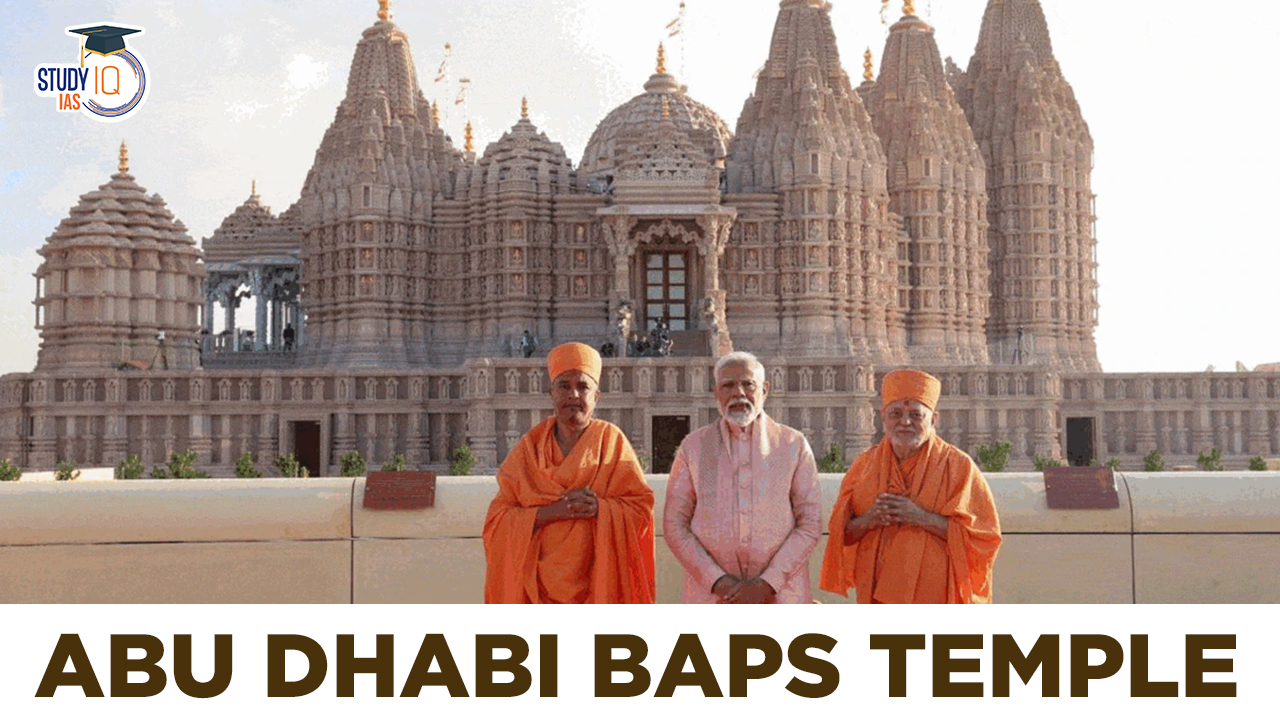Table of Contents
Abu Dhabi BAPS Temple
The BAPS Hindu Mandir in Abu Dhabi stands as a testament to the enduring spirit of cultural unity and religious tolerance. Built by the BAPS Swaminarayan Sanstha, this traditional Hindu temple represents a milestone in interfaith relations, fostering understanding, acceptance, and unity among people of diverse religious backgrounds. Consecrated on 14 February 2024, amidst a grand inaugural ceremony, the mandir’s construction journey reflects a collaborative effort spanning continents and cultures.
PM Modi inaugurated UAE’s 1st Hindu temple
The Festival of Harmony, culminating in the mandir’s consecration, marked a historic moment in the region’s cultural landscape. Prime Minister Narendra Modi’s presence underscored the significance of the event, highlighting the strong ties between India and the UAE. Diplomatic visits and international acclaim further underscored the mandir’s role as a global cultural landmark, promoting the values of peace, tolerance, and mutual understanding.
We’re now on WhatsApp. Click to Join
Historical Background
The vision for the BAPS Hindu Mandir dates back to 1997 when Pramukh Swami Maharaj, the spiritual leader of BAPS, expressed his desire to build a mandir in Abu Dhabi. This vision took shape when the UAE government generously provided 27 acres of land for its construction in August 2015. Spearheaded by Sheikh Mohammed bin Zayed Al Nahyan, the Crown Prince of Abu Dhabi, and supported by Indian Prime Minister Narendra Modi, the project received widespread acclaim for its message of unity and harmony.
Features of BAPS Hindu Mandir in Abu Dhabi
The BAPS Hindu Mandir in Abu Dhabi is not just a place of worship but a magnificent architectural marvel that embodies the rich cultural heritage of Hinduism. Here are some key features of the temple:
- Architectural Splendor: The BAPS Hindu Mandir in Abu Dhabi boasts exquisite architecture that reflects traditional Hindu design principles. Built with pink sandstone from northern Rajasthan and marble from Italy, the mandir stands as a testament to the skilled craftsmanship of artisans from India.
- Symbolism and Significance: Every aspect of the mandir is laden with symbolism and spiritual significance. From its towering spires to intricately carved pillars, each element serves to evoke a sense of reverence and awe among visitors.
- Size and Scale: The mandir is one of the largest Hindu temples in the region, spanning 27 acres of land. Its monumental size, with a height of 108 feet, length of 262 feet, and width of 180 feet, makes it a prominent landmark in Abu Dhabi.
- Diverse Deities: The mandir houses murtis (sacred images) of various Hindu deities, including Swaminarayan, Radha-Krishna, Rama-Sita, Shiva-Parvati, Jagannath, Venkateswara, and Ayyappan. This diverse pantheon reflects the inclusive nature of Hinduism and welcomes worshippers from different traditions.
- Cultural Integration: One of the remarkable aspects of the BAPS Hindu Mandir is its integration of diverse cultural elements. In addition to Hindu motifs and narratives, the temple also features carvings depicting stories from Arabian, Egyptian, Mesopotamian, and Native American civilizations. This fusion of cultures promotes interfaith harmony and mutual understanding.
- Modern Amenities: While the mandir remains true to traditional Hindu architectural styles, it also incorporates modern amenities to cater to the needs of contemporary worshippers. Facilities such as a visitor center, prayer halls, exhibition spaces, sports areas for children, thematic gardens, water features, food courts, and a books and gift shop enhance the overall experience for visitors.
- Environmental Consciousness: The construction of the mandir emphasizes environmental sustainability and eco-friendly practices. Recycled materials are used for furnishings, and features such as a waterfall symbolizing holy rivers and sensors for monitoring seismic activity demonstrate a commitment to environmental stewardship.
- Interfaith Dialogue: The BAPS Hindu Mandir serves as a platform for interfaith dialogue and cultural exchange. Its open-door policy welcomes people of all faiths to visit, learn, and engage in dialogue, fostering mutual respect and understanding among diverse communities.
In summary, the BAPS Hindu Mandir in Abu Dhabi is not only a place of worship but also a symbol of cultural heritage, architectural excellence, environmental consciousness, and interfaith harmony. Its grandeur and significance transcend religious boundaries, making it a beacon of spirituality and cultural exchange in the heart of the UAE.
Construction Endeavors
Groundbreaking ceremonies and stone consecrations marked significant milestones in the mandir’s construction journey. Beginning in December 2019, skilled artisans meticulously crafted the temple using pink sandstone from northern Rajasthan and marble from Italy. The use of digital modeling and seismic simulation ensured structural integrity while minimizing environmental impact. Over 690,000 volunteer hours, contributed by individuals from diverse backgrounds and nationalities, underscored the collective commitment to realizing this architectural marvel.
Architectural Marvel
The BAPS Hindu Mandir stands as the largest temple in West Asia, boasting impressive dimensions of 108 feet in height, 262 feet in length, and 180 feet in width. Its architectural grandeur, characterized by intricate carvings and ornate spires, reflects a fusion of Indian craftsmanship and Emirati symbolism. The mandir’s design incorporates elements from Hindu scriptures alongside depictions of Arabian, Egyptian, and Mesopotamian civilizations, symbolizing the convergence of cultures and civilizations.
Symbolism and Cultural Harmony
The mandir’s inauguration heralded a new era of cultural exchange and mutual respect. Embracing the UAE’s ethos of tolerance and pluralism, the temple serves as a beacon of interfaith understanding. Its ornate carvings depict stories from Hindu mythology, alongside parables from diverse cultural traditions, fostering a spirit of inclusivity and mutual respect. The mandir’s architectural features, such as the ‘Dome of Harmony’ and the waterfall symbolizing holy rivers, further underscore its role as a symbol of global unity.
Abu Dhabi BAPS Temple UPSC
The BAPS Hindu Mandir in Abu Dhabi transcends its role as a place of worship, embodying the shared values of humanity and cultural harmony. Its construction, steeped in collaboration and goodwill, exemplifies the power of unity amidst diversity. As the mandir opens its doors to the public, it beckons individuals of all faiths to experience its spiritual splendor and embrace the timeless message of peace and harmony it embodies.


 RailOne App: Indian Railways Launches Al...
RailOne App: Indian Railways Launches Al...
 Special Intensive Revision (SIR) of Elec...
Special Intensive Revision (SIR) of Elec...
 Daily Quiz 01 July 2025
Daily Quiz 01 July 2025





















